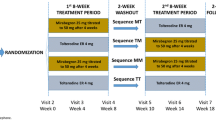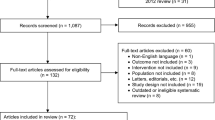Abstract
The incidence, severity and tolerability of dry mouth was compared in 790 women with overactive bladder who were treated with extended-release oxybutynin chloride 10 mg/day or extended-release tolterodine tartrate 4 mg/day for 12 weeks in a multicenter, double-blind, parallel-group study. Dry mouth was the most common adverse event associated with treatment, with an incidence rate of 28.1% in the oxybutynin group and 21.6% in the tolterodine group (P = 0.039). The majority of dry mouth events were mild in both treatment groups. Severe dry mouth occurred in 1.5% and 0.5% of patients in the oxybutynin and tolterodine groups, respectively (P = 0.173). Seven patients on extended-release oxybutynin and 4 patients on extended-release tolterodine discontinued treatment due to dry mouth (P = 0.380). The results of this analysis showed that dry mouth was common with both treatments, but most events were mild; there was no difference in the rate of severe dry mouth or in the rate of withdrawal due to dry mouth.
Similar content being viewed by others
References
YE Yarker KL Goa A. Fitton (1995) ArticleTitleOxybutynin: a review of its pharmacodynamic and pharmacokinetic properties, and its therapeutic use in detrusor stability Drugs Aging 6 243–262 Occurrence Handle7620236
R. Appell (1997) ArticleTitleClinical efficacy and safety of tolterodine in the treatment of overactive bladder: a pooled analysis Urology 50 IssueIDSuppl 90–96 Occurrence Handle10.1016/S0090-4295(97)00599-2 Occurrence Handle9426760
E Versi R Appell D Mobley et al. (2000) ArticleTitleDry mouth with conventional and controlled-release oxybutynin in urinary incontinence Obstet Gynecol 95 718–721 Occurrence Handle10.1016/S0029-7844(99)00661-4 Occurrence Handle10775736
L Rentzhog SL Stanton L Cardozo et al. (1998) ArticleTitleEfficacy and safety of tolterodine in patients with detrusor instability: a dose-ranging study Br J Urol 81 42–48 Occurrence Handle9467475
TO Närhi JH Meurman A. Ainamo (1999) ArticleTitleXerostomia and hyposalivation: causes, consequences and treatment in the elderly Drugs Aging 15 103–116 Occurrence Handle10495070
FC Astor KL Hanft JO. Ciocon (1999) ArticleTitleXerostomia: a prevalent condition in the elderly Ear Nose Throat J 78 476–479 Occurrence Handle10429321
WJ Loesche J Bromberg MS Terpenning et al. (1995) ArticleTitleXerostomia, xerogenic medications and food avoidances in selected geriatric groups J Am Geriatr Soc 43 401–407 Occurrence Handle7706631
NL Rhodus J. Brown (1990) ArticleTitleThe association of xerostomia and inadequate intake in older adults J Am Diet Assoc 90 1688–1692 Occurrence Handle2131338
G Sathyan MB Chancellor SK. Gupta (2001) ArticleTitleEffect of OROS ® controlled-release delivery on the pharmacokinetics and pharmacodynamics of oxybutynin chloride Br J Clin Pharmacol 52 409–417 Occurrence Handle10.1046/j.0306-5251.2001.01463.x Occurrence Handle11678784
RU Anderson D Mobley B Blank et al. (1999) ArticleTitleOnce daily controlled versus immediate release oxybutynin chloride for urge urinary incontinence J Urol 161 1809–1812 Occurrence Handle10.1097/00005392-199906000-00020 Occurrence Handle10332441
MB Chancellor RA Appell G Sathyan SK. Gupta (2001) ArticleTitleA comparison of the effects on saliva output of oxybutynin chloride and tolterodine tartrate Clin Ther 23 753–760 Occurrence Handle10.1016/S0149-2918(01)80024-2 Occurrence Handle11394733
P Abrams R Freeman C Anderstrom A. Mattiasson (1998) ArticleTitleTolterodine, a new antimuscarinic agent: as effective but better tolerated than oxybutynin in patients with an overactive bladder Br J Urol 81 801–810 Occurrence Handle9666761
HP Drutz RA Appell D Gleason et al. (1999) ArticleTitleClinical efficacy and safety of tolterodine compared to oxybutynin and placebo in patients with overactive bladder Int Urogynecol J 10 283–289 Occurrence Handle10.1007/s001929970003
RA Appell P Sand R Dmochowski et al. (2001) ArticleTitleOBJECT Study Group. Prospective randomized controlled trial of extended-release oxybutynin chloride and tolterodine tartrate in the treatment of overactive bladder: results of the OBJECT study Mayo Clin Proc 76 358–363 Occurrence Handle11322350
Detrol® tolterodine tartrate tablets prescribing information. Pharmacia & Upjohn Company, Kalamazoo, MI, July, 2002. Available at: http://www.detrolla.com/files/Detrol.pdf. Accessed September 24, 2003.
AC Diokno RA Appell PK Sand et al. (2003) ArticleTitleProspective, randomized, double-blind, study of the efficacy and tolerability of the extended-release formulations of oxybutynin and tolterodine for overactive bladder: results of the OPERA trial Mayo Clin Proc 78 687–695 Occurrence Handle12934777
K Waldeck B Larsson KE. Andersson (1997) ArticleTitleComparison of oxybutynin and its active metabolite, N-desethyl-oxybutynin, in the human detrusor and parotid gland J Urol 157 1093–1097 Occurrence Handle10.1097/00005392-199703000-00113 Occurrence Handle9072550
J Douchamps F Derenne A Stockis et al. (1988) ArticleTitleThe pharmacokinetics of oxybutynin in man Eur J Clin Pharmacol 35 515–520 Occurrence Handle10.1007/BF00558247 Occurrence Handle3234461
SK Gupta G. Sathyan (1999) ArticleTitlePharmacokinetics of an oral once-a-day controlled-release oxybutynin formulation compared with immediate-release oxybutynin J Clin Pharm 39 22–29
Author information
Authors and Affiliations
Corresponding author
Rights and permissions
About this article
Cite this article
Armstrong, R.B., Luber, K.M. & Peters, K.M. Comparison of Dry Mouth in Women Treated with Extended-Release Formulations of Oxybutynin or Tolterodine for Overactive Bladder. Int Urol Nephrol 37, 247–252 (2005). https://doi.org/10.1007/s11255-004-4703-7
Issue Date:
DOI: https://doi.org/10.1007/s11255-004-4703-7




